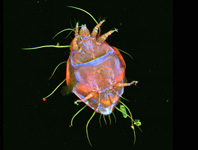Abstract
In 2009, a hitherto unknown Laonome species was found in the Canal Ghent-Terneuzen in the Netherlands and subsequently in other Dutch rivers, canals and estuaries. A few years later, more unknown Laonome specimens were found in the eastern part of the Baltic Sea and in the Don River estuary, Sea of Azov. Initially, it was assumed that these specimens could represent Laonome calida Capa, 2007, originally described from Australia. In the present study we examine all these unknown European Laonome specimens and compare these specimens with the type material of L. calida from Australia. This lead to two main results: First, all specimens from Europe have the same diagnostic characters and therefore belong to one species. This finding was also supported by the results of a correspondence analysis, and genetic analyses using four different DNA sequences (COI, 16S, 28S). Second, it turned out that the type material of L. calida contains two morphologically distinct groups of specimens. The holotype and 7 paratypes are similar to each other but differ significantly from the other also similar 16 paratypes, and from all European specimens. On the basis of these observations, the Laonome specimens from European waters are described here as L. xeprovala sp. nov. We also provide the characters of the branchial crown of three Laonome species for a prospective revision of this genus.
References
Bastrop, R. & Blank, M. (2006) Multiple invasions–a polychaete genus enters the Baltic Sea. Biological Invasions, 8 (5), 1195–1200.
https://doi.org/10.1007/s10530-005-6186-6Bick, A. (2005) A new Spionidae (Polychaeta) from North Carolina, and a redescription of Marenzelleria wireni Augener, 1913, from Spitsbergen, with a key for all species of Marenzelleria. Helgoland Marine Research, 59 (4), 265–272.
https://doi.org/10.1007/s10152-005-0002-7Bick, A. & Randel, N. (2005) Ontogenetic variations in characters of Euchone analis (Krøyer, 1856) (Polychaeta, Sabellidae, Sabellinae) from Spitsbergen, and new assignments of Oriopsis ingelorae Plate, 1995 and O. liefdefjordensis Plate, 1995. Acta Zoologica, 86 (2), 45–157.
https://doi.org/10.1111/j.1463-6395.2005.00196.xBoltachova, N.A., Lisitskaya, E.V., Frolenko, L.N., Kovalev, E.A. & Brabashin, T.O. (2017) The finding of polychaete Laonome calida Capa, 2007 (Annelida: Sabellidae) in the southeast Sea of Azov. Russian Journal of Biological Invasions, 8 (4), 203–306.
https://doi.org/10.1134/S2075111717040026Capa, M. (2007) Taxonomic revision and phylogenetic relationship of apomorphic sabellids (Polychaeta) from Australia. Invertebrate Systematics, 21, 537–567.
https://doi.org/10.1071/IS07002Capa, M., Giangrande, A., de M. Nogueira, J.M. & Tovar-Hernández, M.A. (2016) Sabellidae Latreille, 1825. In: Westheide, W. & Purschke, G. (Eds.), Handbook of Zoology Online. A Natural History of the Phyla of the Animal Kingdom. De Gruyter, Berlin/Boston, pp. 1–42.
Capa, M., Nogueira, J.M.M. & Rossi, M.C.S. (2011) Comparative internal structure of dorsal lips and radiolar appendages in Sabellidae (Polychaeta) and phylogenetic implications. Journal of Morphology, 272, 302–319.
https://doi.org/10.1002/jmor.10914Capa, M., van Moorsel, G. & Tempelman, D. (2014) The Australian feather-duster worm Laonome calida Capa, 2007 (Annelida: Sabellidae) introduced into European inland waters? Bioinvasions Records, 3 (1), 1–11.
https://doi.org/10.3391/bir.2014.3.1.01Evenkamp, H. (1931) Morphologie, Histologie und Biologie der Sabellidenspecies Laonome kroyeri Malmgr. und Euchone papillosa M. Sars. Zoologische Jahrbücher. Abteilung für Anatomie und Ontogenie der Tiere, 53, 405–534.
Fitzhugh, K. (2002) Fan worm polychaetes (Sabellidae: Sabellinae) collected during the Thai-Danish Bioshelf Project. Phuket Marine Biological Center Special Publication, 24, 353–424.
Fitzhugh, K. (2003) A new species of Megalomma Johansson, 1927 (Polychaeta: Sabellidae: Sabellinae) from Taiwan, with comments on sabellid dorsal lip classification. Zoological Studies, 42 (1), 106–134.
Hsieh, H.L. (1995) Laonome albicingillum, a new fan worm species (Polychaeta: Sabellidae: Sabellinae) from Taiwan. Proceedings of the Biological Society of Washington, 108 (1), 130–135.
Hutchings, P.A. & Murray, A. (1984) Taxonomy of polychaetes from the Hawkesbury River and the southern estuaries of New South Wales, Australia. Records of the Australian Museum, 3 (Supplement), 1–118.
https://doi.org/10.3853/j.0812-7387.3.1984.101ICES WGITMO (2016) Report of the Working Group on Introductions and Transfers of Marine Organisms (WGITMO), 16–18 March 2016, Olbia, Italy. ICES CM 2016/SSGEPI, 10, 1–201.
Kotta, J., Kotta, I., Bick, A., Bastrop, R. & Väinölä, R. (2015) Modelling habitat range and seasonality of a new, non indigenous polychaete Laonome sp. (Sabellida, Sabellidae) in Pärnu Bay, the north-eastern Baltic Sea. Aquatic Invasions, 10 (3), 275–285.
https://doi.org/10.3391/ai.2015.10.3.03Malmgren, A.J. (1866) Nordiska Hafs-Annulater. Öfversigt af Kongliga Svenska Vetenskaps Akademiens Förhandlingar, 22, 355–410.
Möller, T. & Kotta, J. (2017) Rangia cuneata (G. B. Sowerby I, 1831) continues its invasion in the Baltic Sea: the first record in Pärnu Bay, Estonia. BioInvasions Records, 6 (2), 167–172.
https://doi.org/10.3391/bir.2017.6.2.13Nogueira, J.M.M., Fitzhugh, K. & Rossi, M.C.S. (2010) A new genus and new species of fan worms (Polychaeta: Sabellidae) from Atlantic and Pacific Oceans–the formal treatment of taxon names as explanatory hypotheses. Zootaxa, 2603, 1–52.
Pabis, K., Krodkiewska, M. & Cebulska, K. (2017) Alien freshwater polychaetes Hypania invalida (Grube, 1860) and Laonome calida Capa, 2007 in the upper Odra River (Baltic Sea catchment area). Knowledge and Management of Aquatic Ecosystems, 418, 46.
https://doi.org/10.1051/kmae/2017033Rao, C.A.N. (1992) Polychaete fauna of the Rushikulya estuary, Ganjam, Orissa. Environmental Ecology, 10 (2), 478–479.
Richardson, K.C., Jarett, L. & Finke, E.H. (1960) Embedding in epoxy resins for ultrathin sectioning in electron microscopy. Stain Technology, 35, 313–323.
https://doi.org/10.3109/10520296009114754Shen, S.-P. & Qi, S. (1982) Fresh water polychaetes from the Pearl River of Guangzhou. Jinan Liyi Xuebao, 5 (1), 66–77.
Southern, R. (1921) Polychaeta of the Chilka Lake and also of fresh and brackish waters in other parts of India. Memoirs of the Indian Museum Calcutta, 5, 563–659.
Sunder Raj, S.K. & Sanjeeva Raj, P.J. (1987) Polychaeta of the Pulicat Lake (Tamil Nadu). The Journal of the Bombay Natural History Society, 84 (1), 84–104.
Syomin, V.L., Kovalenko, E.P. & Savikin, A.I. (2015) Aracia sp. (Polychaeta: Sabellidae) from the Don River estuary (Sea of Azov basin). Russian Journal of Biological Invasions, 6 (1), 65–67.
https://doi.org/10.1134/S2075111715010075

